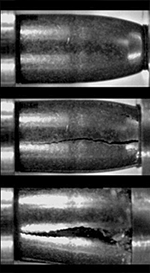

This article has multiple issues. Please help improve it or discuss these issues on the talk page. (Learn how and when to remove these template messages)
|
A material is said to be frangible if through deformation it tends to break up into fragments, rather than deforming elastically and retaining its cohesion as a single object. Common crackers are examples of frangible materials, while fresh bread, which deforms plastically, is not frangible.
A structure is frangible if it breaks, distorts, or yields on impact so as to present a minimum hazard. A frangible structure is usually designed to be of minimum mass.

A frangible light pole base is designed to break away when a vehicle strikes it. This lessens the risk of injury to occupants of the vehicle.[1]
Following a serious incident where an aircraft hit a donut lighting structure at San Francisco International airport,[2] the FAA instigated frangible design rules for such structures.[3] A frangible object was defined as "an object of low mass, designed to break, distort or yield on impact, so as to present the minimum hazard to aircraft". This characteristic is seemingly contradictory to the operational requirements for stiffness and rigidity imposed on this type of equipment.
In order to develop international regulation for the frangibility of equipment or installations at airports, required for air navigation purposes (e.g., approach lighting towers, meteorological equipment, radio navigational aids) and their support structures,[4] ICAO initiated the "Frangible Aids Study Group" in 1981, with the task to define design requirements, design guidelines and test procedures. This work has resulted in part 6 of the Aerodrome Design Manual, dedicated to frangibility.[5]
An overview of the activities carried out to achieve these results is given in "Frangibility of Approach Lighting Structures at Airports".[6] The missing reference (17) in this article is in "Impact simulation of a frangible approach light structure by an aircraft wing section".[7] With the evolution of numerical methods suitable for impact analysis, a Chapter 6 was added to the Aerodrome Design Manual part 6, dedicated to "numerical simulation methods for evaluating frangibility". It states that numerical methods can be used to evaluate the frangibility of structures, but that the analytical models should still be verified through a series of representative field tests.
Of all equipment or installations at airports required for air navigation purposes, ICAO has not yet formulated frangibility criteria for the tower structure supporting the ILS glide path antenna, "considering its unique nature", basically: its size. A first publication on this subject is given in "Frangible design of instrument landing system/glide slope towers".[8]

Afrangible bullet is one that is designed to disintegrate into tiny particles upon impact to minimize their penetration for reasons of range safety, to limit environmental impact, or to limit the danger behind the intended target. Examples are the Glaser Safety Slug and the breaching round.
Frangible bullets will disintegrate upon contact with a surface harder than the bullet itself. Frangible bullets are often used by shooters engaging in close quarter combat training to avoid ricochets; targets are placed on steel backing plates that serve to completely fragment the bullet. Frangible bullets are typically made of non-toxic metals, and are frequently used on "green" ranges and outdoor ranges where lead abatement is a concern.[9][10]
Tempered glass is said to be frangible when it fractures and breaks into many small pieces.[11]
Some security tapes and labels are intentionally weak or have brittle components. The intent is to deter tampering by making it almost impossible to remove intact.[12]
State Project Engineer ... was adamant that changing the old design features for ones having the newer designs was a waste of the taxpayers' money. The features were only a few months old and the probability of any one of them getting hit was very small. One day a friend of his left the roadway and hit a light pole with a rigid design. His friend was killed in the accident. After learning of the tragedy, the Project Engineer had a change of heart. He reasoned that a frangible base costing a few hundred dollars would have saved his friend's life.
Two passengers, ..., were seriously injured by parts of the Approach Light System structure which penetrated the passenger compartment
A break-away fiberglass mast for use in low impact resistant (LIR) structures to support airport approach lighting systems has been developed. This design will withstand 100 mph winds (including gusts) without ice and 75 mph winds (including gusts) with a 1/2 inch radial ice load. Yet, when struck by a light airplane wing, it breaks into pieces without catastrophic damage to the wing. It was observed that impact energy needed to break the mast was in the order of 679 foot-pounds and that peak forces were in the order of 5,656 lbs.
[Dr. John C. Mauro] went on to note how soda-lime glass is tempered to improve its strength. However, that tempering process also makes the interior of glass more stressed. "So when it fractures, it breaks in a catastrophic fashion (i.e., breaking in many small pieces; so-called 'frangibility')," Mauro said. "This is in contrast to an untempered borosilicate glass, which would break into much larger pieces compared to a tempered soda-lime."
Passive seals take a variety of forms. They can be frangible foils or films; plastic wraps; pressure-sensitive adhesive labels; "locking" bolts, crimped wires/cables, or other (theoretically) irreversible mechanical assemblies; tamper-evident packaging and security containers or enclosures that give evidence of being opened; fiber optic bundles that show changes in light transmission when cut; and other devices or materials that display irreversible damage or changes when manipulated.